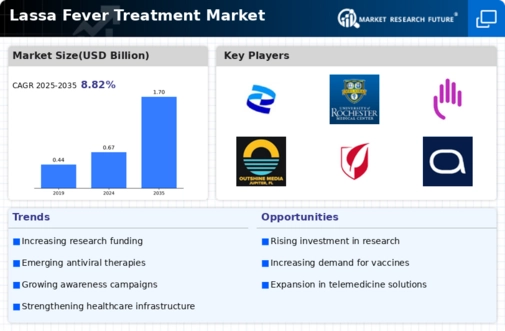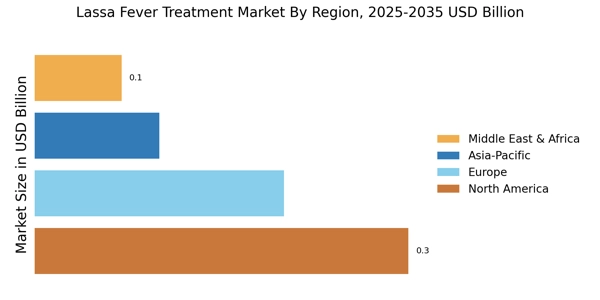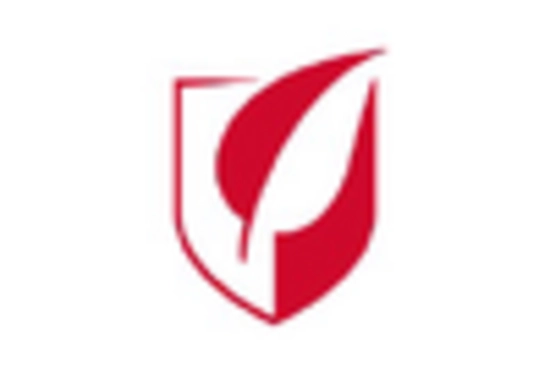Rising Incidence of Lassa Fever
The increasing incidence of Lassa fever in endemic regions appears to be a primary driver for the Lassa Fever Treatment Market. Reports indicate that the number of cases has been on the rise, with thousands of infections reported annually. This surge in cases necessitates the development and availability of effective treatment options. As healthcare systems grapple with the burden of this viral hemorrhagic fever, the demand for antiviral therapies and supportive care is likely to escalate. Consequently, pharmaceutical companies are investing in research and development to create innovative treatments, thereby expanding the Lassa Fever Treatment Market. The urgency to address this public health challenge may lead to increased funding and resources allocated towards combating Lassa fever, further propelling market growth.
Increased Awareness and Education
Increased awareness and education regarding Lassa fever are likely to drive the Lassa Fever Treatment Market. Public health campaigns aimed at educating communities about the transmission, symptoms, and prevention of Lassa fever are essential in reducing the incidence of the disease. As awareness grows, individuals may seek medical attention more promptly, leading to earlier diagnosis and treatment. This proactive approach can potentially improve patient outcomes and reduce the overall burden on healthcare systems. Furthermore, healthcare professionals are being trained to recognize and manage Lassa fever cases effectively, which may enhance the treatment landscape. The combination of heightened awareness and improved education is expected to contribute positively to the Lassa Fever Treatment Market.
Government Initiatives and Funding
Government initiatives aimed at combating infectious diseases, including Lassa fever, are likely to play a crucial role in shaping the Lassa Fever Treatment Market. Various health authorities are recognizing the need for enhanced surveillance, research, and treatment options for Lassa fever. Increased funding for public health programs and research grants is expected to facilitate the development of new therapies and improve access to existing treatments. For instance, initiatives that promote collaboration between government agencies and pharmaceutical companies may lead to accelerated drug development processes. This collaborative approach could potentially enhance the efficacy of treatments available in the Lassa Fever Treatment Market, ultimately benefiting patients and healthcare providers alike.
Technological Advancements in Treatment
Technological advancements in treatment methodologies are poised to significantly influence the Lassa Fever Treatment Market. Innovations in drug formulation, delivery systems, and therapeutic approaches are emerging, which may enhance the effectiveness of existing treatments. For example, the development of novel antiviral agents and combination therapies could provide more effective options for managing Lassa fever. Additionally, advancements in telemedicine and digital health technologies may improve patient access to treatment and monitoring, particularly in remote areas where Lassa fever is prevalent. As these technologies continue to evolve, they are likely to reshape the landscape of the Lassa Fever Treatment Market, offering new avenues for patient care and treatment efficacy.
Emerging Research on Antiviral Therapies
Emerging research on antiviral therapies specifically targeting Lassa fever is anticipated to be a significant driver for the Lassa Fever Treatment Market. Recent studies have focused on identifying effective antiviral compounds that can inhibit the Lassa virus, leading to promising results. The exploration of novel therapeutic agents, including monoclonal antibodies and small molecule inhibitors, may provide new hope for patients affected by this disease. As research progresses, the potential for these therapies to enter clinical trials and subsequently gain regulatory approval could reshape treatment options available in the Lassa Fever Treatment Market. This ongoing research not only highlights the scientific community's commitment to addressing Lassa fever but also underscores the potential for market expansion as new therapies become available.

















